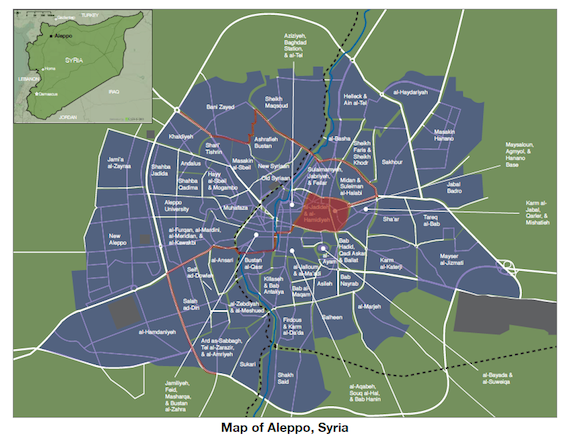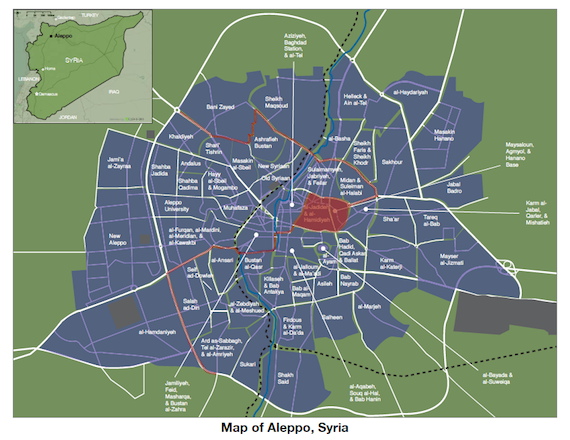By Juan Cole | (Informed Comment) | – –
Both regime sources and the Britain-based Syria Observatory said Tuesday that the Syrian Arab Army and its Shiite militia allies from Lebanon and Iraq had taken the district of Shaar in the East Aleppo pocket. In the past two weeks rebel forces have lost the northeast sections of the pocket and now the regime is penetrating toward the center of the Old City. Regime sources said they not only had all of Shaar but also had advanced into Karem al-Qaterji.

Dubai-based Alarabiya reported that some of the remaining rebel fighters, estimated at just two or three thousand, are now proposing an immediate 5-day humanitarian cessation of hostilities. In part, this step is aimed at allowing the some 500 wounded in the southeast Aleppo pocket to be evacuated (little medical care is available in East Aleppo). They also propose that trapped civilians who want to leave be allowed to transit to the area northeast of Aleppo, which is relatively safe. Probably on the order of 150,000 noncombatants are besieged along with the fighters. And, they urge that negotiations over the future of the city be opened.
A big problem is that Russia and Damascus are in control of the military situation and do not need to negotiate, since they are winning. They also appear to feel no compunctions about their ongoing endangerment of noncombatant lives in the pocket.
Russia is also intensively bombing positions of the Levantine Conquest Front (formerly Nusra Front), Syria’s al-Qaeda affiliate, in the northern rural, largely Sunni Arab province of Idlib. These sorts of aerial bombardment are relatively useless except when done in conjunction with an advancing land force. Such air-infantry coordination is taking place in southeastern Aleppo. But in Idlib the bombing is mostly for psychological effect, and also to keep the Levantine Conquest Front off balance. The remaining rebels in southeast Aleppo have made a united front with al-Qaeda to keep Russia from singling it out and dividing rebel ranks. Unfortunately that means they are formally allied with al-Qaeda, making it difficult for them to pick up outside support.
Since 2013, the Syrian rebels have turned increasingly fundamentalist and they have had one major goal– to cut Damascus off from resupply and so to take the capital, forcing the regime out of power. Their initial attempt to cut Damascus off focused on Homs and Qusayr, which the Nusra Front and other hard line militias took, and then used them to cut supplies to Damascus coming down by truck from the Mediterranean port of Latakia. But the spring 2013 intervention by Lebanon’s Hizbullah allowed the regime to recover Homs and Qusayr, and so to forestall a siege of Damascus.
Then in spring 2015, the Nusra Front and its allies took all of Idlib, and tried to use it as a springboard to take the port of Latakia to the east. This thrust would, again, have potentially cut off Damascus from resupply. If you take the capital of a country, usually you win the civil war.
But then Russia intervened by air to push Nusra/ al-Qaeda and its allies back from Latakia. That was the real reason the Turks were so angry that they shot down a Russian jet in November of 2015. The Russian intervention has allowed the regime to strengthen its defenses in Homs and in Latakia, and so to protect supply lines to Damascus. With Russian air cover, the regime was able to kill the leader of the Saudi-backed Jaysh al-Islam (Army of Islam) and to drive it back from the north of Damascus. The regime was able to extend control south and so frustrate the Jordan and US-backed guerrillas moving up from the south toward Damascus.
When East Aleppo falls, likely sometime in December, the regime will have control of all of the major urban areas of the country, some 80% of the population.
I keep seeing well informed Syria analysts allege that the rebels have 40 or 50% of Syria. This is not true. They have a lot of eastern desert sand. But I figure the rebels now control only 20% or so of the population, and that is about to go down to more like 15%.
Some analysts correctly say that the war will likely continue even after East Aleppo falls. But this point is only partly correct. Some groups will hold out in Idlib and in the Golan and on the Jordan border. But unlike with Homs 2013 or Idlib 2015, they no longer have a strategic path forward to strangling the regime. It is they who are being strangled.
So in that sense the war is over save for some shooting. The rebels don’t appear to have any prospect of actually winning. And that situation is hardly a platform for attracting new fighters. The rebellion is in the throes of a reverse snowball effect. Eventually it will peter out, though that day may not be near.
The crushing of the rebellion is a tragedy, since Syria has a seedy one-party state that tortures people to death and brooks no criticism. But the rebellion also did lose its soul on the whole, moving toward hard line fundamentalism and pledging to ethnically cleanse 2 million Alawite Shiites. It will take decades for Syria to recover from this moment of horrible choices on all sides.



 © 2025 All Rights Reserved
© 2025 All Rights Reserved